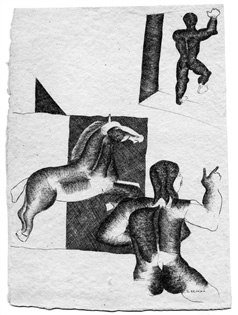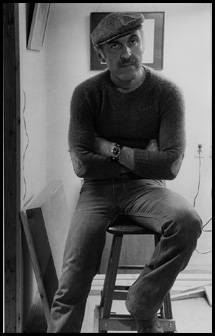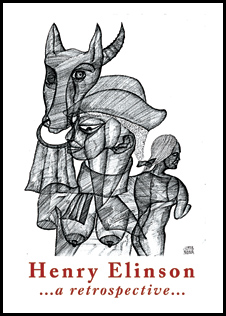Henry Elinson 1935-2010
| Go to gallery |
Henry Elinson (1935-2010)
It is with profound sadness that I inform friends and admirers of Henry Elinson that the artist passed away on Monday, January 18, in Pacific Grove, California, after a long bout with cancer, two weeks before the closing of his retrospective at Porto Franco Art Parlor in San Francisco.
Elinson was born in 1935 in St. Petersburg, Russia. He studied philosophy and pedagogy, worked for many years as a speech therapist with mentally handicapped children, but by 1960’s had become consumed with art. He became a key member of the first unofficial, nonconformist art circles and avant-garde exhibitions of the Soviet underground and was questioned and blacklisted by the KGB. No longer able to exhibit his work, he immigrated to USA in 1973. He worked at Yale University and taught Russian for many years at the Defense Language Institute in Monterey, California. All the while, he worked relentlessly as an artist, pursuing his unique, uncompromising vision in graphic art.
Elinson’s work has been exhibited nationally and internationally at venues including Banakh Gallery (with Mikhail Chemiakin), Nakhamkin, Paule Anglim, and other galleries and museums in New York, San Francisco, Washington, Paris, Milan, Berlin, London, St. Petersburg, and Tokyo. He was awarded a Gold Medal in Art Achievement by the city of Milan, and his work is held in various public and private collections including Museum of Fine Arts, San Francisco, University Art Museum, Berkeley, Yale University Gallery, Monterey Museum of Art, Bochum Museum (Germany), Russian State Museum (St. Petersburg), and Museum of Nonconformist Art (St. Petersburg). His work has received reviews by Naum Gabo and other prominent critics and artists in national and international publications including Artforum, Artweek, and Washington Post.
As a person, Henry Elinson was as remarkable as he was an artist. We belonged to different generations – I was a son of his friends – yet despite his at times blunt manner, he had a gentle, tormented soul and a knack for effortlessly bonding with young people: beginning artists, musicians, and poets. I traveled in Paris with him in my late teens, and he would recite poetry by memory for hours as we walked, especially that of Joseph Brodsky, who was his idol. He could be abrupt, but he would never talk down or be gratuitously dismissive; instead he freely shared his spirit and listened very well. As common as such attitude might be here and now, for a Russian artist of his generation, it was more than refreshing. He was generous in praise and ruthless yet inspiring in criticism, so it is no wonder that quite a few young people sought counsel from Elinson before they ever would from their own parents. A visit with him, even when he was gravely ill, was always an unpredictable intellectual foray, and in his last days he showed his friends nothing but kindness and generosity. He is survived by his wife, Ludmila, daughter Masha, and a granddaughter. He will be missed by many, young and old, in distant corners of the world, as an artist, mentor, and a kindred spirit.
A retrospective of Elinson’s abstract and figurative pastels and works on paper will continue at Porto Franco Art Parlor until January 30.
Paul Belasky
Stairway to Nowhere
by Mihail Chemiakin
“But the heart draws us on to the useless, the excessive, in objects and actions. Wherever lie the unnecessary and the useless, that is where the spirit rejoices, there is the seal of perfection.” Fyodor Sologub
 I have known Elinson’s work for many years. His strange angular forms of people and birds that make us think of the eternal solitude of the individual, of the ineluctability of dying alone. Elinson’s works are wrapped in autumnal sadness. It is pointless to look for merriment or emotional outbursts in his work. His works are a curious mix of the psychological nakedness of Erich Maria Remarque and the sacred madness of Prague melancholic Franz Kafka. Elinson’s oeuvre belongs to only one sorrowful season of nature, a season which, however, thinking people cannot do without.
In Borges’ novella The Immortal, Homer builds an absurd city, a city of insane architecture where houses have no windows or doors and stairways lead nowhere. This city is the creation of philosophers who are disenchanted with everything. Their stairways to nowhere lead Borges to the gates of the Temple of Art.
Most likely, Henry Elinson is one of the architects of this “Homerian city”. On his stairways wander sorrowful people, thinking about the unknown.
I have known Elinson’s work for many years. His strange angular forms of people and birds that make us think of the eternal solitude of the individual, of the ineluctability of dying alone. Elinson’s works are wrapped in autumnal sadness. It is pointless to look for merriment or emotional outbursts in his work. His works are a curious mix of the psychological nakedness of Erich Maria Remarque and the sacred madness of Prague melancholic Franz Kafka. Elinson’s oeuvre belongs to only one sorrowful season of nature, a season which, however, thinking people cannot do without.
In Borges’ novella The Immortal, Homer builds an absurd city, a city of insane architecture where houses have no windows or doors and stairways lead nowhere. This city is the creation of philosophers who are disenchanted with everything. Their stairways to nowhere lead Borges to the gates of the Temple of Art.
Most likely, Henry Elinson is one of the architects of this “Homerian city”. On his stairways wander sorrowful people, thinking about the unknown.
January 2010
Biography

Henry Elinson by Martha Casanave,1980
Paul Belasky
WORKS CITED (1) Hurst, W. Sheldon, “Orchestrating Forms: An Introduction to Cyrillic Cabala II: Pastels by Henry Elinson”. ACC, NY, 2002. (2) Kreid, V., “Henry Elinson”. Museum of Nonconformist Art, St. Petersburg, Russia, 2000. (3) Rannit, A., “Eight Drawings: Henry Elinson” in New Directions in Prose and Poetry, edited by J. Laughlin. New York: A New Directions Book, 1976. (4) Brookman, D., “Exploring Gestural Posibilities”, Artweek, v. 18:44, 1987. (5) Bowlt, J.E., “Henry Elinson, Gallery Paule Anglim”, Artforum, 1981 BIOGRAPHY 1935 Born in Leningrad, USSR (now St. Petersburg, Russia) 1954 Studied three years at Leningrad Pedagogical Institute 1960 Studied three years at Moscow Pedagogical Institute 1960-73 Considered part of Novoye Levo (New Left) group of painters in Leningrad 1960-67 Worked at school for mentally handicapped children 1962 Participated in underground exhibition in Leningrad (disrupted by police action). 1967-73 Worked as speech therapist in psychiatric clinic in Leningrad. 1969 Exhibition in Leningrad with three architects. 1973 Emigrated from USSR to NYC; left most of his art works, taking only the few for which he could pay the departure tax. 1974 Moved to Yale University in New Haven, CT. 1976 Took position at Defense Language Institute in Monterey Peninsula, CA. 1993 Retired, continues to exhibit his art and write short stories and novels in Russian. WORKS IN PERMANENT COLLECTIONS: Museum of Fine Arts, San Francisco, CA Yale University Art Gallery, New Haven, CT Monterey Museum of Art, Monterey, CA University Art Museum, Berkeley, CA Bochum Museum, Germany State Russian Museum, St. Petersburg, Russia Zimmerly Art Museum, Rutgers University, New Brunswick, NJ Duke University Museum of Art, Durham, NC The Mead Art Museum, Amherst College, MA Collection of Contemporary Art, Central Exhibition Hall, St. Petersburg, Russia Museum of St. Petersburg History, St. Petersburg, Russia Museum of Nonconformist Art, St. Petersburg, Russia State Hermitage, St. Petersburg, Russia EXHIBITIONS 2001-02 Abstract Art in Russia in the Twentieth Century, Russian Museum, St. Petersburg. 2000 Museum of Non Conformist Art, St. Petersburg, Russia 1998 Gallery Paule Anglim, San Francisco, CA 1998 The Mead Art Museum, Amherst College, MA 1996 Duke University Museum of Art, Durham, NC Gallery Paule Anglim, San Francisco, CA 1995 Morlan Gallery, Transylvania University, Lexington, KY 1994 Santa Cruz Art Museum, The Art Is ... Santa Cruz, CA 1993 Gallery Paule Anglim, San Francisco, CA 1992 Dostoyevsky Museum, Art of Depression St. Petersburg, Russia 1991 Gallery Paule Anglim, San Francisco, CA 1989 University Union Gallery, California Polytechnic Institute, San Luis Obispo, CA 1987 Gallery Paule Anglim, San Francisco, CA 1987 Richard Art Center, Bay Area Drawing, Richmond, CA 1987 Clara Hatton Gallery, Sixteen Bay Area Artists 1987 Colorado State Univ., Fort Collins, CO 1985 Gallery Paule Anglim, San Francisco, CA 1981 Gallery Paule Anglim, San Francisco, CA, Beyond the Looking Glass - Other Art of Russia 1980 Stanford University, Palo Alto, CA 1980 Nakhamkin Gallery, NYC 1979 Museum of Fine Arts, San Francisco, CA 1978 Nelson Gallery University of California, Davis, CA 1978 Nakhamkin Gallery, NYC Galerie Hardy, Paris, France Musee du Vieux Chateau de Laval, France Musee des Beaux-Arts de Tours, France Musee des Beaux-Arts de Chartres, France Kunstamt Charlottenburg, Germany Gallerie Junger Kunstler, Germany Ernest-Lemmer Institute, Germany Saarland Museum, Moderna Gallerie Saarbrucken, Germany Pratt Inst., New Art from the Soviet Union, NYC Museum of Tokyo, Non-official Soviet Contemporary Art, Japan 1977 Monterey Peninsula Museum of Art, Monterey,CA International Exhibition to Aid Political Prisoners Katya Granoff Galerie, Paris, France International Exhibition to Aid Political Prisoners Parkway Focus Gallery, London, Eng. International Exhibition of Graphique, West Berlin, Germany New Art from the Soviet Union, Washington, DC Rowe House Gallery, Washington, DC Banah Gallery with Mikhail Chemiakine and others, NYC 1976 Palais des Congres, Contemporary Russian Art, Paris, France New Art from the Soviet Union, St. Louis, MO 1975 Circolo Della Galleria, Milan, Italy Galleria II Punto, Genova, Italy 1974 Light & Motion Transmutation Art Galleries, NYC Thor Gallery, Louisville, KY Brooklyn College Student Center, Brooklyn, NY New York University, NYC